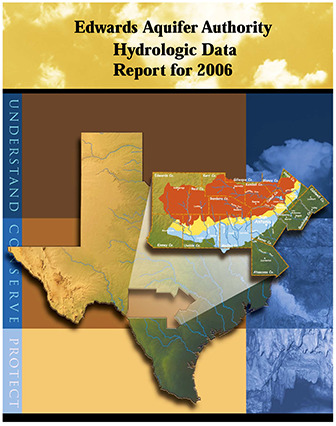Edwards Aquifer Authority Hydrologic Data Report for 2006

| Author | Hamilton M, Johnson S, Mireles J, Esquilin R, Burgoon C, Luevano G, Gregory D, Gloyd R, Sterzenback J, Mendoza R, and Schindel GM |
| Year | 2007 |
| Description | Annual report for 2006 on recharge, discharge, water levels and water quality in the Edwards Aquifer San Antonio Region |
| Report Number | 07-01 |
| Publisher | Edwards Aquifer Authority |
| Location | Edwards Aquifer - San Antonio Area |
| Cover | View Download |
| File | View Download |
| Summary |
|
(Excerpted from report Summary) This report presents results of the Authority’s Edwards Aquifer Data Collection Program for calendar year 2006. … Water levels were generally below the historical mean value at the Bexar County (J-17) index well throughout 2006. Other wells in the region exhibited similar behavior. In 2006, aquifer (groundwater) levels were adversely affected by the continuing drought conditions across the region, resulting in water levels that were lower than those recorded in calendar year 2005. … Precipitation in the Edwards Aquifer region was below the period of record mean in 2006….Total recharge to the Edwards Aquifer was 201,600 acre-feet in 2006, or approximately 36 percent of the median value of 560,900 acre-feet for the period of record (1934-2006). …In calendar year 2006, groundwater discharge from the Edwards Aquifer through wells and springs totaled 768,400 acre-feet. This amount is approximately 12 percent above the median value of 683,500 acre-feet for the period of record (1934-2006). … Water samples from most sampling events were analyzed for major ions, metals, TDS, hardness, and nutrients. Wells and spring groups were also analyzed for VOCs. Water samples from 10 wells and all spring groups were analyzed for SVOCs. Water samples collected from wells, stream locations, and spring groups were also analyzed for pesticides, herbicides, and PCBs. … For well water samples collected in 2006, mercury was detected at one location in the saline zone at 2.7 μg/L, slightly above the 2.0 μg/L MCL. Other metals detected included strontium and iron, at concentrations above their respective PCLs, or secondary standards. Surface water sample analyses did not indicate the presence of any analyzed metals above their respective standards. Spring water samples indicated the presence of mercury, thallium, and antimony at concentrations below MCLs and PCLs in 2006. For samples collected in 2006, nitrate-nitrite as nitrogen concentrations ranged from below the laboratory reporting limit of 0.015 mg/L to 6.70 mg/L in samples from wells, streams, and springs in the Edwards Aquifer region. …In 2006, wells and springs were all analyzed for VOCs; carbon disulfide was detected at trace amounts in Hays County, as was chloroethane. These detections were well below their PCL values. In addition, these detections were from wells within the saline water zone of the aquifer. Laboratory quality assurance data indicated the presence of carbon disulfide in the associated trip blanks. … No SVOCs were detected at or above their associated MCLs in wells sampled. However, the compound bis(2-ethylhexyl)phthalate was detected at 11.4 μg/L in the sample from Las Moras (Fort Clark) Springs. The MCL for bis(2-ethylhexyl)phthalate is 6.0 μg/L. One additional SVOC, phenol , was detected in this sample at concentrations below the MCL. … The pesticide compound malathion was detected in a well in Uvalde County in trace amounts. Edwards Aquifer water is generally of such high quality that it normally requires only chlorination to meet public drinking water standards. However, detection in the aquifer of nitrates and organic compounds, as well as trace quantities of metals, is a concern, and the Authority will continue to monitor for these compounds to determine possible sources and trends. Nitrate as nitrogen was detected frequently in all sample types; however, well samples had the highest concentrations, with 24 of 76 wells sampled testing positive for nitrate-nitrite at 2.0 mg/L or higher. One of the 76 wells had nitrate-nitrite concentrations above 5.0 mg/L; the MCL for nitrate-nitrite is 10 mg/L.… Confirmed detections of anthropogenic compounds, such as malathion from a Uvalde County well and SVOC detections at Las Moras Springs, are a concern and warrant continued monitoring in the future. The Authority’s aquifer-wide water-quality sampling program will continue to monitor wells, streams, and springs for indications of water-quality impacts throughout the region. … In addition to the routine water quality samples discussed previously, the Authority collected 123 special samples from 24 wells in response to the release of raw sewage over the recharge zone of the aquifer at two different locations in 2006. The first incident occurred between December 2005 and January 2006, at Evans Road and Highway 281 in north Bexar County. The second incident occurred in Hollywood Park, also in north Bexar County. Both incidents occurred as a result of failed pressurized sewer lines. … Although some bacterial samples were positive, none of the samples indicated a positive interception of the anticipated plume of sewage. |
Search for Documents
Advance Search
Explore EAA's Scientific Reports
- All Reports
- RZ Protection
- Aquifer Levels
- Remote Sensing
- Precipitation
- Overview Studies
- Modeling
- Hydrology and Hydrogeology
- History
- Groundwater Recharge, Recharge Zone
- Groundwater Movement
- Geomorphology and Caves
- Weather Modification
- Geology
- Water Use and Conservation
- Geochemistry
- Water Resources Planning and Management
- Floods and Drought
- Water Quality
- Climatology
- Surface Water / Groundwater Relationship
- Biology
- Springs, Groundwater Discharge
- Archaeology
